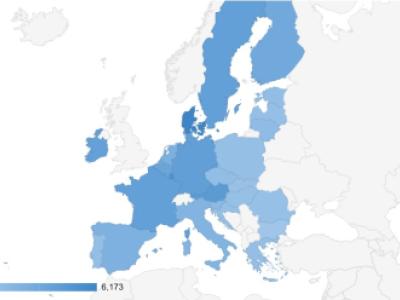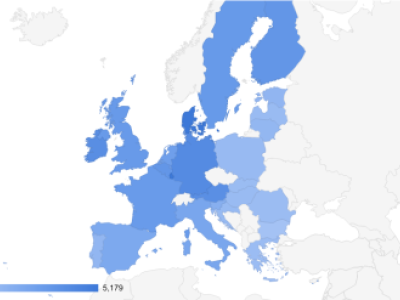For the fourth year in a row, I'm publishing my humble observations on average salary changes in the European Union. In this article, I've decided to compare average salary in 2017 with 2014.
Update: Average Salary in European Union 2018
For previous archives see: Average salary in EU: 2016, 2015, 2014
I wouldn't call bellow written a scientific research, as most of the data in this article are taken from Wikipedia's article List of European countries by average wage. To make it more interesting I've added the year of 2014 as a reference and made some simple calculations in Google Sheets. Data provided below might not be 100% accurate but they should give an overall insight on average salary levels across European Union member countries.
The average salary in European Union member countries 2017
If compared to 2014, average median salary has increased by about 2.02% during the past three years. The average salary in EU as of 2017 stands at EUR 1,520 monthly what is up from EUR 1489 in 2014
Now, there is a new leader with the most average salary in Denmark (EUR 3,095) overtaking longtime leader Luxembourg and leaving it on second place with EUR 3,095 monthly. Speaking of the bottom end Bulgaria and Romania take the last places with an average salary in EU, (EUR 406 and EUR 515, respectively).

The average salary in European Union 2017
The gap between richest (Denmark) and poorest (Bulgaria) is 7.6. Which actually is shrinking, as in 2016 the gap between Luxembourg and Bulgaria was more than 8 times.
There is one thing that should be kept in mind, not all countries in this list use EUR, in fact, there are 9 out of 28 countries in EU using their national currencies instead of EUR. ( Bulgaria, Croatia, Czech Republic, Denmark, Hungary, Poland, Romania, Sweden and the United Kingdom)
From table below you will notice there is negative average salary growth in 9 countries during the past three years, for countries like Denmark, Sweden, United Kingdom I can it explain because of their national currencies been volatile against EUR and USD currencies. For other countries, it would ask more investigation, what is not the main topic of this article (though you are more than welcome to leave your feedback in the comments section)
| EUR | Growth | ||||
| Rank | Country | 2017 | 2014 | Money | % |
| 1 | Denmark | 3,095 | 3,122 | -27 | -0.87 |
| 2 | Luxembourg | 3,009 | 3,189 | -180 | -5.98 |
| 3 | Finland | 2,509 | 2,330 | 179 | 7.13 |
| 4 | Sweden | 2,465 | 2,690 | -225 | -9.13 |
| 5 | Ireland | 2,464 | 2,160 | 304 | 12.34 |
| 6 | Germany | 2,270 | 2,054 | 216 | 9.52 |
| 7 | Netherlands | 2,263 | 2,136 | 127 | 5.61 |
| 8 | France | 2,157 | 2,128 | 29 | 1.34 |
| 9 | United Kingdom | 2,102 | 2,597 | -495 | -23.55 |
| 10 | Belgium | 2,091 | 1,946 | 145 | 6.93 |
| 11 | Austria | 2,009 | 2,114 | -105 | -5.23 |
| 12 | Italy | 1,762 | 1,923 | -161 | -9.14 |
| 13 | Spain | 1,718 | 1,615 | 103 | 6.00 |
| 14 | Cyprus | 1,658 | 1,833 | -175 | -10.55 |
| 15 | Slovenia | 1,074 | 1,044 | 30 | 2.79 |
| 16 | Malta | 1,021 | 1,092 | -71 | -6.95 |
| 17 | Portugal | 984 | 985 | -1 | -0.10 |
| 18 | Greece | 947 | 818 | 129 | 13.62 |
| 19 | Estonia | 945 | 841 | 104 | 11.01 |
| 20 | Czech Republic | 837 | 701 | 136 | 16.25 |
| 21 | Croatia | 792 | 710 | 82 | 10.35 |
| 22 | Slovakia | 755 | 683 | 72 | 9.54 |
| 23 | Poland | 752 | 678 | 74 | 9.84 |
| 24 | Latvia | 703 | 557 | 146 | 20.77 |
| 25 | Lithuania | 637 | 524 | 113 | 17.74 |
| 26 | Hungary | 622 | 503 | 119 | 19.13 |
| 27 | Romania | 515 | 398 | 117 | 22.72 |
| 28 | Bulgaria | 406 | 333 | 73 | 17.98 |
| Average | 1,520 | 1,489 | 31 | 2.02 | |
Data source: List of European countries by average wage
This is a list of countries containing monthly (annual divided by 12 months) net income (after taxes) average wages in Europe in EUR currency.The table above reflects the average (mean) wage as reported by various data providers. In less developed markets, actual incomes may exceed those listed in the table due to the existence of grey economies.
While the median average wage in EU is about EUR 1,520 not all countries are equal, so, for example, the largest average salary have been registered in Denmark (EUR 3,095) while the lowest in Bulgaria (EUR 406).
If compared to 2016, there are no significant changes in overall development, and we still can observe that the median EUR 1,500 average wage divides EU by half - there are 14 countries where the average wage is above that line, and there are 14 countries where the average salary is below the median.
In fact, just two out of fourteen countries were median average salary is below EU average (Slovenia and Malta) has average salary just barely more than EUR 1,000, making the rest from camp 'below the median average salary in EU' with even less than EUR 1,000 average monthly salary.
How does your country stand at this table? Readers and I would love to hear! Drop a comment!

